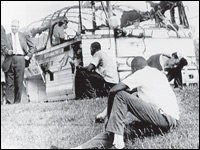01.16.17A Martin Luther King Day Reflection on Courage

Courage, Defined
For the past few years I’ve tried to spend the morning of MLK day studying the details of his life, usually by re-reading sections of my favorite books on the subject, Taylor Branch’s America in the King Years trilogy. Last year I started writing about my annual reflection on King’s life and work.
This morning I opened at semi-random and began re-reading the almost inconceivable history of the Freedom Rides. A few hours later I was still reading. It is incredible how much courage Freedom Riders demonstrated and how much this country required that courage less than 60 years ago to save it from its own worst self- racism and repression normalized and part of the infrastructure of daily life. The story reminded me of how much Dr. King’s own courage fed off the courage of a thousand others, some known, many more anonymous- educated and not, white and black, and vice versa. Courage begets courage. It did so over and again throughout the civil rights movement.
Anyway I thought I’d re-tell one story in particular from the Freedom Rides. I’ll pick up the story in Montgomery, Alabama with the first group of Freedom Riders—black and white citizens who set out to ride interstate buses together from DC to New Orleans in the summer of 1961 to cause the government to enforce laws against segregation of interstate buses and the stations that served them. It sounds like a small battle, maybe, in hindsight and without context, but it was monumental. And bloody. The first group of Freedom Riders were met at bus stations in the South by angry mobs with baseball bats and pipes. It wasn’t just bluster and threat. The riders were beaten bloody—and sometimes unconscious–as they got off the buses and sometimes—in Anniston, Alabama while on the buses merely for sitting together, black and white. Soon local authorities, especially in Montgomery, contrived to have police disappear for the first 10 or 15 minutes when the bus pulled into a station so that mobs of ‘segregationists’- klansmen and the like- could attack the riders, which they did with bloody relish. When the police did step in, in Montgomery Alabama, it was to arrest the freedom riders for provoking a riot. They were accountable for the violence against them.
The bus first group of riders was in was firebombed outside Anniston. Only a gun wielding undercover agent managed to make the people barring the door let them off the burning bus (see picture above). They were beaten bloody twice in a day and then arrested in Montgomery. They were ready to give up when a group of reinforcements volunteered to relieve them and carry the ride forward. That group tried to board buses in Montgomery and were arrested and dumped at the Alabama state line in the middle of the night, whereupon they arranged to be driven back to Montgomery to continue their journey. That’s where I’ll pick up the story.
The next stop was Birmingham and the riders knew it would be bad. US attorney general had demanded that state and local authorities protect the riders but when they arrived in Birmingham there was not a police officer in sight. Only an angry white mob. The leader of the riders, who had several times walked off buses defenselessly into the face of sure violence, assembled the riders on the empty platform. A small group of reporters asked him a question but before he could answer the riders and the reporters were besieged. Here are some of the details.
The leader of the riders was beaten unconscious. Women and men alike were beaten by the crowd. The men were beaten viciously- one, on the ground and being kicked and beaten, was rolled over and lifted up so one man held his head between his knees and others beat him in the face systematically. Even reporters covering the event were beaten, in at least one case beaten brutally with their camera equipment, for reporting the events to the outside world An assistant to Attorney General Bobby Kennedy, there to observe, was beaten unconscious and left under his car when he tried to rescue two female freedom riders and drive them to safety.
After being beaten unconscious by this state sanctioned mob, the leader got up and assembled his group. They huddled by the police—who arrested them for breach of peace—because they were their only protection. Eventually they found a way to a hospital that would treat them—often hospitals refused to treat the bloodied freedom riders. But a few days later as they recovered, reporters asked them what they would do. The riders were alone in a city without rule of law, with citizens trying to kill them, with the police not only unwilling to protect them but complicit in their attack, with hospitals unwilling to treat them. Their lives were in danger. But the leader announced they would get on the bus and continue their journey and ride deeper into danger and quite possibly their own death. Reporters could not believe the answer. The courage of the leader and his group was so overwhelming that many did not even recognize it as courage. They called it foolish. But that I guess is that nature of courage and the power of a leader who expresses it.
That leader was Congressman John Lewis.
I thought that story needed telling. Happy Martin Luther King Jr. day.
